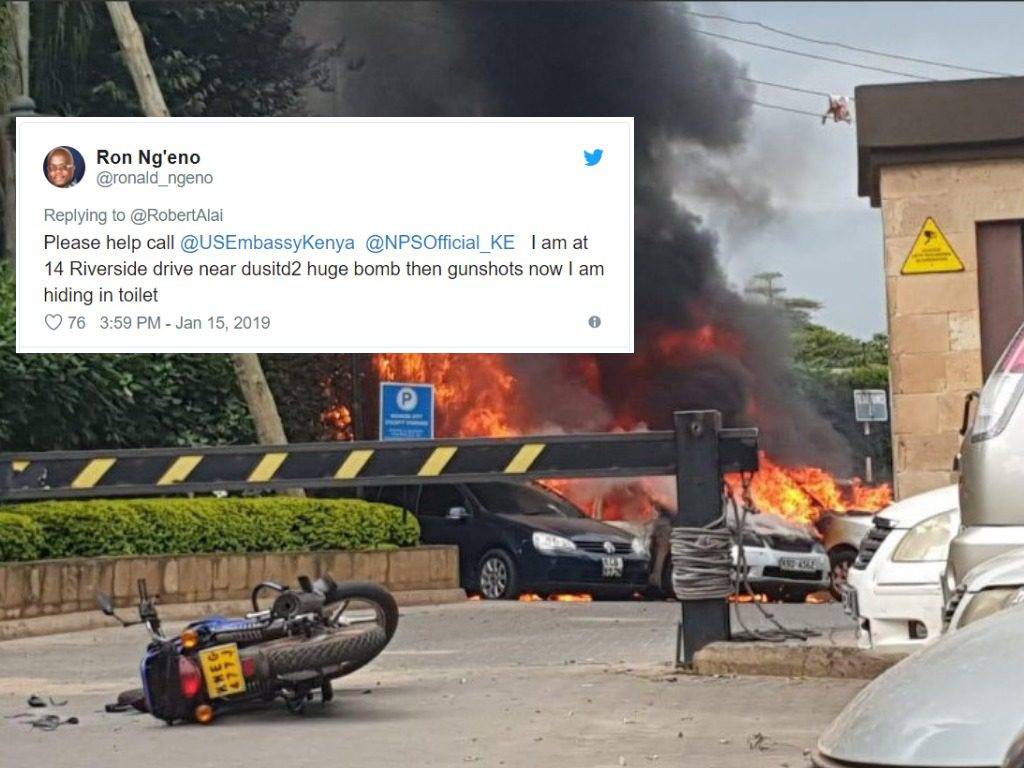Role of Social Media During Kenya’s 14 Riverside Attack: From the Cries for Help to the Fake News

As the dust settles on Kenya’s recent terror attack at the heart of the capital city, a lot of lessons emerge from these happenings. Not only security lessons but how times have changed and the role social media plays when it comes to dissemination of information during such critical times. Unlike previous times when most people would learn of such happenings through the TV, this time around, even the media was getting information through social media – Twitter, Facebook and WhatsApp.
I remember the happenings of Tuesday afternoon quite well, I was not at 14 Riverside, neither was I close but I am quite grateful that I was scrolling through Twitter at that particular time. See, my colleague was meant to have a meeting at the premise at around 5 pm, he was to leave for the meeting at 4 PM, but as he was getting ready to order his ride, something on Twitter caught my attention.
Quite a number of tweets were coming in with questions as to what was transpiring at 14 Riverside, famous for hosting the Dusit D2 Hotel:
“What’s happening at 14 Riverside?”
“Explosions at Dusit”
“Gunshots heard at 14 Riverside”
These are just some of the words that were trending on Twitter at around 3.45pm. After going through my timeline, I decided to warn my colleague not to leave for Westlands, “why” he asked and I just directed him to Twitter.
#RiversideAttack
Please help call @USEmbassyKenya @NPSOfficial_KE I am at 14 Riverside drive near dusitd2 huge bomb then gunshots now I am hiding in toilet
— Ron Ng'eno (@ronald_ngeno) January 15, 2019
Within a few minutes, 14 Riverside was trending on Twitter with information pouring in from different people, those trapped within the complex, those around the area and even those without a clue of what was happening.
Those trapped within the four walls of 14 Riverside were sending their cries for help through Twitter, alerting relevant authorities of what was happening and like magic, response teams were on the ground, thanks to the power of social media.
It was evident that social media had turned into an information centre…
It was evident that social media had turned into an information centre where even the mainstream media was getting their information from. Despite the confusion and chaos, it was through social media that a true picture of what was happening at 14 Riverside was painted with users going as far as alerting Facebook to activate a Safety Check for those around 14 Riverside.
One man, Ron Ng’eno, a survivor of the 14 Riverside attack had tweeted about the attack from the beginning and gave regular updates including a heartbreaking messaging to his family in the case that he did not make it;
If I die I love the Lord and believe I will go to heaven please tell my family I love then I love you Caleb, Mark and Carol
— Ron Ng'eno (@ronald_ngeno) January 15, 2019
We are still in bathroom gunshots in building, please pray for us.
— Ron Ng'eno (@ronald_ngeno) January 15, 2019
One of the first responders at the scene was celebrated journalist John Allan Namu. He happened to be driving close by when things went down and what did he first do, share live updates of the incident through Twitter. Mainstream media houses were also streaming the happenings live on Twitter, proving again that social media is slowly taking over as a means to pass information.
The Fake News
Like any other ungoverned platform, there’s no shortage of people trying to pass around the wrong information. Just as the cries for help and information about the incident was streaming in through various social media platforms, a few people took the opportunity to spread lies.
There were a few tweets passing the wrong information around, regarding the number of attackers and possible victims. The spread of fake news was fuelled by the desire for people to be “first” to pass information. This has always been the case as people just want to pass information without first verifying the source, this was especially rampant when there was news about victims of the attack.
A number of people warned of the spread of fake news, calling for Kenyans to first verify the information they have before sharing it, to some extent this worked but it still wasn’t effective as some misleading information was spread around anyway.
Despite this, if there was ever a time to be grateful for social media, it is now. Despite the numerous fingers we point at such technologies for taking away our humanity, social media played a huge role in ensuring the rescue of many people at 14 Riverside.
Dear all thank you for your support. I am now out and at home with my family. Thanks to the brave @NPSOfficial_KE @kdfinfo for risking their lives to save others.
— Ron Ng'eno (@ronald_ngeno) January 16, 2019